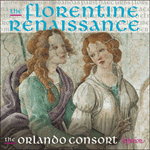Lorenzo de' Medici seems to have held Isaac in genuine affection. He smoothed the composer’s integration into Florentine society, while Isaac in turn set his patron’s poetry to music, and may have taught his children music. When Lorenzo died in 1492, the composer memorialized his patron in several works, including
Quis dabit pacem populo timenti?. This motet draws on Classical precedent, borrowing lines from a funerary chorus from (Pseudo-)Seneca’s tragedy
Hercules Oetaeus. Seneca’s words are supplemented with additional text that explicitly mentions Lorenzo and the Medici. The work is freely composed, without any pre-existent material. Its structure is articulated, rather, through the quantitative poetry of both Seneca and the additions: cadences, changes in vocal scoring, and rests in all voices render the lines and half-lines immediately audible, while the musical motifs often derive their rhythms directly from the longs and shorts of the words in a manner that would gain currency in the German metrical ode tradition of the following century.
from notes by David J Burn © 2021
Lorenzo de' Medici semble avoir porté une véritable affection à Isaac. Il facilita l’intégration du compositeur dans la société florentine pendant qu’Isaac, à son tour, mettait en musique la poésie de son protecteur, et enseignait peut-être la musique à ses enfants. À la mort de Lorenzo en 1492, le compositeur immortalisa son protecteur dans plusieurs œuvres, notamment
Quis dabit pacem populo timenti?. Ce motet s’inspire d’un précédent classique, en empruntant des vers à un chœur funéraire de la tragédie
Hercules Oetaeus attribuée à Sénèque, mais dont la paternité est aujourd’hui remise en question. Un complément au texte de Sénèque mentionne explicitement Lorenzo et les Médicis. Cette œuvre est composée librement, sans le moindre matériel préexistant. Sa structure s’articule, dans une certaine mesure, au travers de la poésie de quantité de Sénèque et des ajouts: les cadences, les changements dans l’écriture vocale, et les silences à toutes les voix rendent les vers et les demi-vers immédiatement audibles, alors que les motifs musicaux tirent souvent directement leurs rythmes des longues et des brèves des mots d’une manière qui allait devenir courante dans la tradition de l’ode métrique allemande au siècle suivant.
extrait des notes rédigées par David J Burn © 2021
Français: Marie-Stella Pâris
Offenbar hatte Lorenzo de' Medici echte Zuneigung zu Isaac gefasst. Er ebnete ihm den Weg in die florentinische Gesellschaft; Isaac seinerseits komponierte Gedichte seines Mäzens, vielleicht unterrichtete er auch dessen Kinder. Als Lorenzo 1492 starb, gedachte Isaac seiner in mehreren Werken, darunter auch die Motette
Quis dabit pacem populo timenti?. Sie folgt einem antiken Vorbild: einem Trauergesang aus der Tragödie
Hercules Oetaeus des (Pseudo-) Seneca. Dessen Worte werden um Zusatztexte ergänzt, die ausdrücklich Lorenzo und die Medici-Familie nennen. Das Werk verzichtet auf alles ältere Material, es ist ganz frei gehalten. Seine Gliederung erhält es ausschließlich durch die textliche Ordnung des Seneca-Gesangs und der Zusatztexte: in allen Stimmen machen Kadenzen, Wechsel der Satzweise und Pausen die Zeilen und Halbzeilen unmittelbar deutlich; die musikalischen Motive gewinnen ihren Rhythmus häufig aus den Längen und Kürzen der Worte—ein Verfahren, das in der deutschen Odendichtung des folgenden Jahrhunderts üblich werden sollte.
aus dem Begleittext von David J Burn © 2021
Deutsch: Friedrich Sprondel


 The Florentine Renaissance
The Florentine Renaissance
